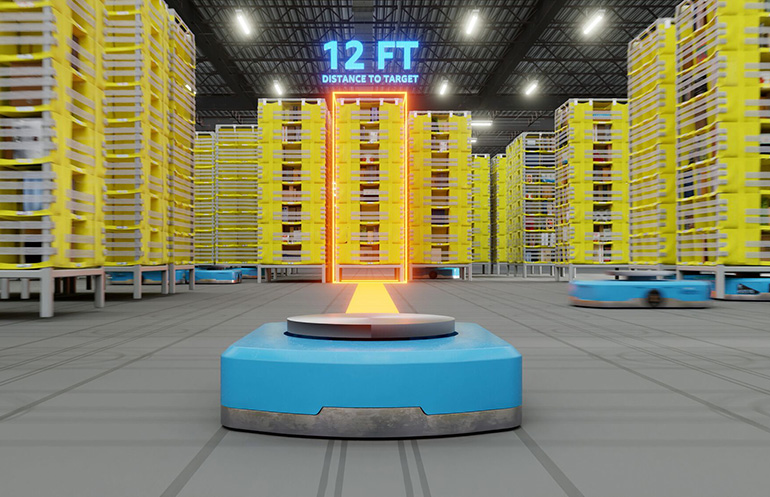
Amazon has deployed 1 million robots across its global network. Source: Amazon
Amazon.com Inc. announced yesterday that it has deployed its 1 millionth robot. The e-commerce company claimed that it has “the world’s largest fleet of industrial mobile robots.”
“I’m excited to share two significant milestones in Amazon’s robotics and AI journey, said Scott Dressner, vice president of Amazon Robotics. “We’ve just deployed our 1 millionth robot, building on our position as the world’s largest manufacturer and operator of mobile robotics.”
The second milestone is Amazon’s introduction of DeepFleet, a generative artificial intelligence foundation model that Dressner said will make the Seattle-based company‘s entire fleet of robots more efficient. The AI technology will coordinate robotic movements across Amazon’s fulfillment network.
Amazon fleet grows worldwide
Amazon recently delivered the 1 millionth robot to a fulfillment center in Japan. It joined the retailer’s global network, which it said spans more than 300 facilities worldwide.
Dressner recalled that Amazon’s robotics journey began with automated guided vehicles (AGVs) from Kiva Systems, which Amazon acquired for $775 million in 2012. The AGVs brought shelves to human pickers.
Ten years later, the company rolled out Proteus, its first fully autonomous mobile robot (AMR). The robots have precision navigation and can safely operate around employees.
Proteus is part of an increasingly diverse fleet, which includes the Hercules robots. The 2024 RBR50 Robotics Innovation Award winner can lift and move up to 1,250 lb. (566.9 kg) of inventory.
Amazon’s Pegasus systems include conveyors to handle individual packages, and the company designed Titan to carry up to 2,500 lb. (1,133.9 kg).

Proteus is Amazon’s first true autonomous mobile robot. Source: Amazon
DeepFleet AI to accelerate robots by 10%
Amazon said DeepFleet will improve the travel times of its robotic fleet by 10% and enable it to deliver packages to customers faster and at lower cost. In 2023, Amazon Logistics processed 5.9 billion orders, equivalent to 16.1 million deliveries per day or 673,500 per hour, reported Capital One Shopping.
“Think of DeepFleet as an intelligent traffic management system for a city filled with cars moving through congested streets,” explained Dressner. “Just as a smart traffic system could reduce wait times and create better routes for drivers, DeepFleet coordinates our robots’ movements to optimize how they navigate our fulfillment centers. This means less congestion, more efficient paths, and faster processing of customer orders.”
The AI model uses Amazon’s extensive inventory-movement data sets and Amazon Web Services tools including SageMaker. It will learn over time and continue to optimize robot collaboration, Dressner said.

The DeepFleet AI will act as a traffic manager for numerous mobile robots. Source: Amazon
Employees get retraining as numbers shift
Amazon noted that its robots work alongside its staffers, taking on repetitive tasks and heavy lifting. According to The Wall Street Journal, the company could soon have as many robots as people.
However, contrary to the popular belief that automation eliminates jobs, Amazon has invested in its workers, asserted Dressner. Since 2019, it has provided training for more than 700,000 employees, including in high-demand technical skills.
“In fact, at our next-generation fulfillment center, launched late last year in Shreveport, La., advanced robotics require 30% more employees in reliability, maintenance, and engineering roles,” he wrote.
In addition, Amazon’s Career Choice program certifies workers to be satellite technicians for its Project Kuiper Internet satellite program.
Amazon focuses on tangible benefits
“Rather than pursuing technology for its own sake, we’re focused on solving real problems,” said Dressner.
“By reducing robot travel time by 10%, we’re not just improving efficiency—we’re creating tangible benefits: faster delivery times, lower operational costs, and reduced energy usage,” he added. “This is how we’re making generative AI work in the real world, delivering concrete value for both employees and customers.
Amazon manufactures its robots in the U.S. and works with local suppliers for global deployments. This allows it to maintain quality and create a feedback loop with its designers, manufacturing teams, and front-line employees, Dressner said.
“Twelve years ago, we worked backwards from a simple problem: how to help employees access inventory more efficiently,” he concluded. “Today, we’re applying the latest AI technology to make our entire robot fleet smarter, ultimately delivering better value to our customers through faster service and lower costs. This is just the beginning.”
The post Amazon launches new AI foundation model, deploys 1 millionth robot appeared first on The Robot Report.

